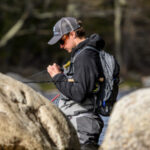Taking to the skies with a baby in tow can feel daunting for many parents. Concerns about safety, comfort, and the overall experience often lead to questions about the earliest age infants can travel by plane. Understanding the guidelines and taking proper precautions can make air travel with your little one a smoother experience. This guide provides expert advice to help you navigate flying with a young baby, ensuring a safe and comfortable journey for both of you.
Minimum Age for Air Travel: When Can Your Newborn Fly?
While the excitement of travel beckons, it’s crucial to consider your newborn’s health and well-being before planning a flight. Generally, it’s recommended to avoid flying with a newborn baby until they are at least 7 days old. Many pediatricians, including those at the American Academy of Pediatrics (AAP), advise waiting even longer if possible. Ideally, waiting until your baby is two or three months old before flying is a more cautious approach.
Why the wait? Newborns have developing immune systems, making them more susceptible to infections. Airports and airplanes are enclosed spaces where germs can easily circulate. Delaying air travel for the first few months minimizes your baby’s exposure to potential illnesses during this vulnerable period.
Lap Infant or Purchased Seat? Prioritizing Your Baby’s Safety
When booking flights, you’ll encounter the option of having your baby as a “lap infant,” typically for children under two years old. While this may seem cost-effective, especially since the Federal Aviation Administration (FAA) doesn’t mandate a separate ticket for this age group, choosing to keep your baby on your lap during a flight is not the safest option.
Turbulence is a significant and unpredictable factor in air travel. It is also the number one cause of injuries to children on airplanes. Holding a baby on your lap, even securely, may not provide adequate protection during unexpected turbulence. In severe turbulence, it can become physically impossible to maintain a secure hold on your baby, putting them at risk of injury.
Alt text: A mother securely holds her infant on her lap during an airplane flight, emphasizing the close proximity but potential safety concerns during turbulence.
For optimal safety, the FAA and AAP recommend that the safest way for babies to fly is in an FAA-approved child safety restraint system, such as a car seat or an airplane harness device. This provides a secure and protective environment for your child throughout the flight, especially during critical phases like takeoff, landing, and turbulence. If you opt not to purchase a separate seat, inquire with your airline about the possibility of using an empty seat to install your car seat, especially on less crowded flights.
Car Seat Safety on Airplanes: The Gold Standard for Infant Air Travel
Using a car seat on an airplane provides a familiar and secure environment for your baby, mirroring the safety they experience in a car. Not all car seats are certified for air travel, so it’s crucial to check for a label that states: “This restraint is certified for use in motor vehicles and aircraft.”
For infants weighing less than 20 pounds, a rear-facing car seat is essential for airplane travel. Children weighing between 20 and 40 pounds should also be restrained in a car seat, either rear-facing or forward-facing depending on the car seat’s specifications and the child’s size. It’s important to note that airplane lap belts alone are not suitable for children under 40 pounds.
For toddlers and children weighing between 22 and 44 pounds, the Child Aviation Restraint System (CARES) offers an FAA-approved alternative to car seats. This harness system is specifically designed for airplane seats and provides secure restraint for toddlers.
Alt text: A young child is safely secured in a forward-facing car seat installed on an airplane seat, highlighting the recommended method for infant and toddler safety during flights.
Car Seat Logistics: Bringing Your Car Seat Onboard
Car seats and strollers generally do not count as checked baggage, though airline policies can vary. It’s always best to confirm with your specific airline before your travel date. Many airlines allow you to check car seats and strollers at the gate at no extra charge, which can reduce the risk of damage compared to checking them with regular baggage. Consider using a protective bag to further safeguard your car seat during transit.
If you have purchased a separate seat for your baby, bringing your FAA-approved car seat onboard is highly recommended. This ensures your baby’s safety and comfort throughout the flight.
Selecting the Best Airplane Seat for Your Baby
Choosing the right seat location can significantly enhance your experience when flying with a baby.
Rows with extra space, such as bulkhead rows, are often good options. However, exit rows are prohibited for passengers with infants and young children due to safety regulations.
Window seats are generally preferable when traveling with a baby. Aisle seats pose risks, particularly during beverage service, where hot drinks could spill and cause burns. Additionally, babies in aisle seats are more vulnerable to injuries from passing carts and falling items from overhead bins. Furthermore, many airlines require car seats to be installed in window seats.
Ensuring your baby’s seat is adjacent to yours is paramount. The U.S. Department of Transportation provides an Airline Family Seating Dashboard to help you understand airline policies on family seating and identify airlines that guarantee adjacent seating for families with young children without extra fees.
Comfort and Sleep Solutions for Long Flights
While car seats offer the safest option, long-haul flights may necessitate additional comfort and sleep considerations for your baby.
Airline bassinets, also known as skycots or baskets, are offered by some airlines, particularly for bulkhead rows. These attach to the bulkhead wall and provide a lie-flat space for babies. Typically, airline bassinets are suitable for babies under 6 months old or weighing less than 20 pounds who cannot yet sit up unaided. Availability and size restrictions vary by airline, so it’s essential to inquire and reserve a bassinet in advance if needed.
Sleeper seats or “sky couches” are another option on some international airlines. For an additional fee, you may be able to book a row of seats with extensions that transform into a larger, lie-flat surface suitable for both parent and child. Some airlines also offer premium “lie-flat” or “flat-bed” seats in certain cabins.
Inflatable seat extenders are individual inflatable cushions that can extend the airplane seat, creating a larger surface for a child to lie down. However, not all airlines permit the use of these devices, so it’s vital to check with your airline beforehand. If allowed, your child will need their own purchased seat to use a seat extender.
Alt text: A baby peacefully sleeps in an airline bassinet attached to the bulkhead wall on an airplane, demonstrating a comfortable sleep option for infants on long flights, subject to airline availability and restrictions.
Important Note: Regardless of the sleep arrangement, your baby must be secured in a car seat or held on your lap during takeoff, landing, and any periods of turbulence.
Maintaining Safe Sleep Practices Aloft
Whether your baby sleeps on your lap or in another device during the flight, safe sleep practices remain crucial.
If your baby sleeps on your lap, stay vigilant and check on them frequently. Ensure their face remains uncovered and that they can breathe easily.
If your baby sleeps in a bassinet or other device, ensure it is firm and flat, and avoid using soft bedding that poses a suffocation risk. Refer to resources on safe sleep practices for infants for detailed guidance.
Navigating Security with Baby Formula and Breast Milk
Traveling with liquid formula or expressed breast milk is permissible, and you are exempt from the standard 3-1-1 liquids rule imposed by the Transportation Security Administration (TSA). TSA allows reasonable quantities of breast milk, formula, and water for mixing formula to pass through security checkpoints.
Pack these liquids separately from your other carry-on items and inform TSA officers that you are carrying them. You may request that these items not be x-rayed, although TSA guidelines indicate that x-ray scanning is generally safe for food and liquids, including breast milk and formula. For detailed information and the latest TSA guidelines, consult the TSA website.
Tips for Keeping Your Baby Comfortable and Content
To help ensure a more pleasant flight for your baby and yourself:
Avoid using diphenhydramine (Benadryl) or similar medications to sedate your baby without consulting your pediatrician. These medications can have unpredictable and potentially serious side effects in infants, especially with repeated doses during long flights. If your doctor approves such medication, test it at home first to observe your baby’s reaction, as some children experience the opposite effect and become more agitated.
Passport Requirements for Babies: International and Domestic Travel
For international flights, every U.S. citizen, including infants, must possess a valid U.S. passport. To apply for your baby’s passport, both parents or guardians must appear in person with the baby, along with the completed application form DS-11, your baby’s birth certificate, and a passport photo taken within the last 6 months.
Passport photos for infants require specific considerations. The photo must feature only the baby, with no other individuals present. For infants who cannot sit upright, you can safely take the photo by laying them on their back on a plain white sheet or blanket to provide head support without holding them. Alternatively, you can cover a car seat with a white sheet and photograph your baby seated in it.
For domestic flights within the United States, a passport is typically not required for babies. However, it’s advisable to check with your specific airline regarding their identification requirements, especially if you need to verify your baby’s age for discounted fares. Note that children under 18 are not required to have a Real ID for domestic air travel.
Optimal Flight Timing: Day or Night for Baby?
Determining the best time of day to fly with a baby is subjective and depends on your baby’s individual sleep patterns and your preferences.
Some infants may sleep more soundly at night than during daytime naps after the initial newborn phase. If you and your baby tend to sleep well on flights, a late-night flight might be a suitable option. Conversely, if your baby is generally more settled during the day, a daytime flight might be preferable. Consider your baby’s typical routine and choose a flight time that aligns with their natural rhythms as much as possible.
Further Resources
For more detailed information and guidance on safe air travel with children, consult these resources:
- Federal Aviation Administration (FAA): https://www.faa.gov/travelers/fly_children/
- Transportation Security Administration (TSA): https://www.tsa.gov/travel/special-procedures/traveling-children
- American Academy of Pediatrics (AAP) HealthyChildren.org: https://www.healthychildren.org
About the Authors:
Claire McCarthy, MD, FAAP is a primary care pediatrician at Boston Children’s Hospital, an Assistant Professor of Pediatrics at Harvard Medical School, a senior editor for Harvard Health Publications, and a spokesperson for the American Academy of Pediatrics.
Jennifer Shu, MD, FAAP, is a pediatrician and author based in Atlanta. She is the medical editor of HealthyChildren.org and co-author of Heading Home With Your Newborn: From Birth to Reality.

